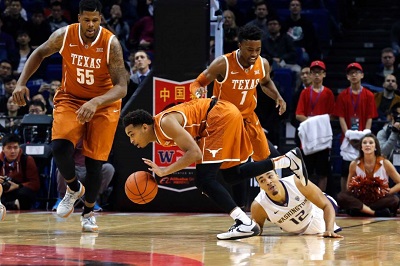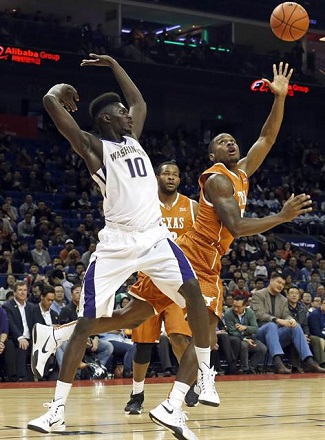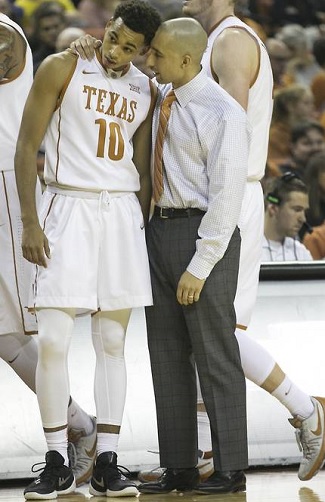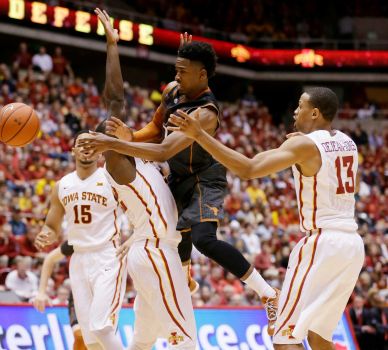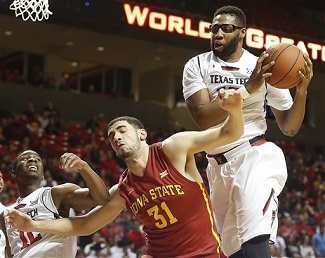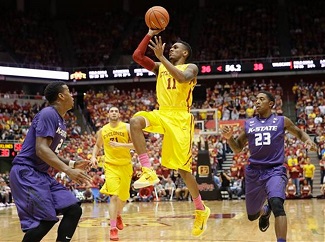Imperial Arena | Paradise Island, Bahamas Tip: 6 P.M. CT | TV: AXS (find your channel) Vegas: Texas -3 | KenPom: Texas, 81-76 (66%) In last night’s first round action at the Battle 4 Atlantis, the Texas Longhorns fell behind early against a Top 25 Texas A&M squad, and could never quite dig completely out of the hole. Despite multiple runs in the second half to get within one possession of the Aggies, Texas was repeatedly stifled by dagger threes and big plays from Texas A&M. As a result, the Longhorns fell into the loser’s bracket, setting up a rematch with Washington. This is the second time the Longhorns and Huskies will play in less than two weeks, with both games coming outside of the United States. Texas has played its three games in three different countries and traveled more than 16,000 miles so far this season, with the Huskies logging more than 14,000 miles of their own.
The theme song for the first Texas/Washington game was “Yakety Sax” The first meeting The season opener, at Mercedes-Benz Arena in Shanghai, was a painful affair. Both teams played very sloppy basketball and found it difficult to adjust the new emphasis on calling textbook fouls that had been ignored in years past. The teams combined for 62 fouls and shot 88 free throws in a game that rarely had a few clean possessions strung together. After a very slow start from both teams, Washington eventually built a small first-half lead Texas managed to eliminate by the break. The Huskies again slowly built their lead throughout the second half, holding a nine-point edge with just over 11 minutes to play. Isaiah Taylor and Demarcus Holland combined for the next 15 Texas points, as the Longhorns trimmed the deficit to just one point with five minutes left. It was a nip-and-tuck one-possession affair for nearly the entire remainder of the game, including a pair of lead changes, but a missed transition three and a missed second attempt by Javan Felix near the one-minute mark proved to be Texas’ last gasp. The Longhorns failed to score in the final 2:09 of the game, and the Huskies iced it away at the free-throw line for a 77-71 victory. Texas was plagued by an inability to secure defensive rebounds and loose balls that seemed to be right within their grasp, particularly when they needed stops down the stretch. The Huskies reclaimed 49% of their missed shots on the day and turned that into 21 second-chance points. Although the Longhorns have a bigger, stronger frontcourt, the quickness and athleticism of the young Washington team proved invaluable when chasing down the ball. Shot selection was also a major issue for the Longhorns, with the team frequently settling for very long threes without any attempt at dribble penetration or ball movement. Washington plays a pressure defense — which resulted in quite a few fouls during the season opener — and it seemed that the Longhorns were frustrated enough to take open shots whenever they presented themselves, regardless of whether or not those shots actually should have been taken in that situation. On paper, Texas was the clear favorite heading into the first game. They played a very poor game and were still in a position to win in the final minutes, but ultimately came up short. The Longhorns are still favored by both Vegas and Pomeroy in tonight’s game, albeit by a smaller margin than the first time around. If Texas can improve on some of its very frustrating shortcomings from the Pac-12 China Game, they should be able to enact revenge tonight. Keys to the Game 1) Attack against the pressure – The Husky defense has proven that the high foul count in Shanghai was not an outlier, as indicated by their season free-throw rate of 51.5%. That statistic means that Washington gives up more than one free throw for every two field goal attempts, a rate that is currently 301st out of 351 Division I teams. In yesterday’s game against Gonzaga, the Huskies actually posted a defensive free throw-rate of 91.7%, which is nearly one free throw given for every shot.
Washington sent Kendal Yancy and Texas to the line frequently Texas found success against Washington when Taylor attacked, and they also found some very nice drives from Eric Davis and Demarcus Holland last night against Texas A&M when their ball movement gave the guards just enough space to blow by with a quick first step. Texas must not be frustrated by Washington’s pressure defense again tonight, and need to drive the ball immediately when they have an angle on the defender. When that angle isn’t there, quick ball movement will find them elsewhere, and will provide another opportunity for a slash to the rim. In addition to earning extra trips to the line, relying on the backcourt may also help the Texas bigs, who have had issues establishing position without picking up offensive fouls. Rather than focus on pounding the ball down low and relying on Cameron Ridley and company to fight for position, repeatedly slashing to the rim should open things up for the bigs on dump-offs underneath, and hopefully keep them from riding pine thanks to offensive fouls. 2) Clean up the defensive glass – While the Longhorns clawed back against Washington in the second half of their first meeting, it seemed like every defensive stop was scuttled by a rebound that was snatched right out of a Texas player’s hands. Much of the Washington offense in their first four games has come from second-chance points, thanks to an offensive rebounding rate that is currently 5th-best in the nation. Since many of the lost defensive rebounds seemed to be a result of being outworked or out-hustled, and not a result of repeatedly being out of position, it’s likely that Texas can make some improvements in that department tonight. The Huskies are not a great shooting team, and with so many freshman, they’ve also made some poor shot choices. If the Longhorns can win back more of the defensive boards tonight than they did in Shanghai, it will make a serious dent in Washington’s scoring chances. 3) Take advantage of Washington’s mistakes – In addition to bad shots, the Huskies have also made quite a few mistakes this year by just playing too quickly. The youngsters have thrown tons of errant passes in transition, with a fair number resulting in turnovers. They also tend to continue pushing when the break isn’t there, resulting in forced shots against a set defense. The poor shot selection is also a hidden form of turnover, as when the defense can win the rebound, those types of shots often lead to runouts the other way. Washington had an incredibly rough start in Shanghai thanks to that sloppy play and an inability to finish some easy looks. Texas was unable to take advantage, however, and allowed Washington to claw their way to a lead midway through the first half. There will likely be quite a few freshman mistakes made by the Huskies tonight, so Texas must capitalize on them this time around. Whether that means extending a lead or charging back from a deficit, this Texas team cannot afford to stall out when Washington is giving them extra possessions. |








